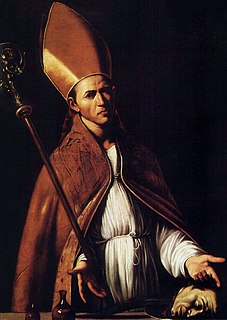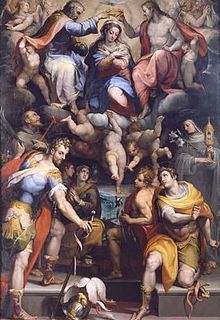Pope Caius, also called Gaius, was the bishop of Rome from 17 December 283 to his death in 296. Little information on Caius is available except that given by the Liber Pontificalis, which relies on a legendary account of the martyrdom of Susanna of Rome for its information. According to legend, Caius baptized the men and women who had been converted by Tiburtius and Castulus. His legend states that Caius took refuge in the catacombs of Rome and died a martyr.

Vitus, whose name is sometimes rendered Guy or Guido, was a Christian martyr from Sicily. His surviving hagiography is pure legend. The dates of his actual life are unknown. He has for long been tied to the Sicilian martyrs Modestus and Crescentia but in the earliest sources it is clear that these were originally different traditions that later became combined. The figures of Modestus and Crescentia are probably fictitious.

Philomena, also known as Saint Philomena or Philomena of Rome was a young virgin martyr whose remains were discovered on May 24–25, 1802, in the Catacomb of Priscilla. Three tiles enclosing the tomb bore an inscription, Pax Tecum Filumena, that was taken to indicate that her name was Filumena, the English form of which is Philomena. Philomena is the patron saint of infants, babies, and youth, and is known as "The Wonder Worker".

The Catacombs of Rome are ancient catacombs, underground burial places in and around Rome, of which there are at least forty, some rediscovered only in recent decades. Though most famous for Christian burials, either in separate catacombs or mixed together, Jews and also adherents of a variety of pagan Roman religions were buried in catacombs, beginning in the 2nd century AD, occasioned by the ancient Roman ban on burials within a city, and also as a response to overcrowding and shortage of land. The most extensive and perhaps the best known is the Christian Catacomb of Callixtus located near the Park of the Caffarella, but there are other sites, both Christian and not, scattered around the city, some of which are now engulfed by modern urban sprawl.

Januarius, also known as Januarius I of Benevento, was Bishop of Benevento and is a martyr and saint of the Catholic Church and the Eastern Orthodox Church. While no contemporary sources on his life are preserved, later sources and legends claim that he died during the Great Persecution, which ended with Diocletian's retirement in 305.
Cyriacus, sometimes Anglicized as Cyriac, according to Christian tradition, is a Christian martyr who was killed in the Diocletianic Persecution. He is one of twenty-seven saints, most of them martyrs, who bear this name, of whom only seven are honoured by a specific mention of their names in the Roman Martyrology.

Saint Anastasia is a Christian saint and martyr who died at Sirmium in the Roman province of Pannonia Secunda. In the Eastern Orthodox Church, she is venerated as St. Anastasia the Pharmakolytria, i.e. "Deliverer from Potions".

October 7 - Eastern Orthodox liturgical calendar - October 9

Nabor and Felix were Christian martyrs thought to have been killed during the Great Persecution under the Roman emperor Diocletian. A tomb in Milan is believed to contain their relics.

The Four Crowned Martyrs or Four Holy Crowned Ones were nine individuals who are venerated as martyrs and saints of Early Christianity. The nine saints are divided into two groups:
- Severus, Severian(us), Carpophorus (Carpoforus), Victorinus
- Claudius, Castorius, Symphorian (Simpronian), Nicostratus, and Simplicius

Saints Cyrus and John are venerated as martyrs. They are especially venerated by the Coptic Church and surnamed Wonderworking Unmercenaries because they healed the sick free of charge.

Saint Julia of Corsica, also known as Saint Julia of Carthage, and more rarely Saint Julia of Nonza, was a virgin martyr who is venerated as a Christian saint. The date of her death is most probably on or after AD 439. She and Saint Devota are the patron saints of Corsica in the Catholic Church. Saint Julia was declared a patroness of Corsica by the Church on 5 August 1809; Saint Devota, on 14 March 1820. Both were martyred in pre-Christian Corsica under Roman rule. Julia's feast day is 23 May in the Western liturgical calendar and 16 July in the East.

Saints Victor and Corona are two Christian martyrs. Victor was a Roman soldier who was tortured and killed; Corona was killed for comforting him. Corona is invoked as a patron of causes involving money; she was not historically associated with pandemics or disease, but has been invoked against the coronavirus pandemic.

Saints Victoria, Anatolia, and Audax are venerated as martyrs and saints by the Catholic Church. Victoria and Anatolia are mentioned in the Roman Martyrology under the date of 10 July. Anatolia was first mentioned in the De Laude Sanctorum composed in 396 by Victrice (Victricius), bishop of Rouen (330-409).
Saints Lucy and Geminian were venerated on 16 September as saints who died as martyrs in Rome during the persecution of Diocletian in about 290 or 300 or, more precisely, in 304. Veneration for them was ancient but their story is "only known from fabulous acts." Lucy appears to be in reality the same as the Lucy of Syracuse whose feast is on 13 December, but the Geminian who was venerated on 16 September seems to be a fictitious character, not to be confused with Saint Geminianus, Bishop of Modena.
Trofimena is a female saint canonised in the Roman Catholic Church. Originally from the town of Patti in Sicily, the relics of Trofimena are venerated in the basilica in the town of Minori, Italy on the coast of Amalfi, southern Italy.

Eleutherius (or Eleut erus or Eleftherios; sometimes called Liberalis or Liberator, the former transliterations and the latter translations of his and his mother Antia are venerated as Christian saints and martyrs in Albania.

Pontianus was a second century Christian martyr. He was martyred during the reign of the Emperor Marcus Aurelius. He is honored as a saint and martyr by the Catholic Church, the Old Catholic Church, and the Eastern Orthodox Church. In Spoleto, Italy, he is invoked for protection against earthquakes.

Ancona Cathedral is a Roman Catholic cathedral in Ancona, central Italy, dedicated to Saint Cyriacus. It is the seat of the Archbishop of Ancona. The building is an example of mixed Romanesque-Byzantine and Gothic elements, and stands on the site of the former acropolis of the Greek city, the Guasco hill which overlooks Ancona and its gulf.

Luxurius or Luxorius was an ancient Roman official on Sardinia in the late 3rd and early 4th centuries. Apparitor to Delphius, the praeses or governor of the island, he was converted to Christianity by reading the Psalms. He possibly was beheaded on 21 August for refusing to sacrifice to idols in the city of Forum Traiani, probably in 304 during the fourth of Diocletian's persecutions. Later he was venerated as a martyr and saint by the Roman Catholic Church.
















